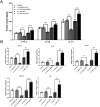TAGAP activates Th17 cell differentiation by promoting RhoA and NLRP3 to accelerate rheumatoid arthritis development
- PMID: 37458218
- PMCID: PMC10711349
- DOI: 10.1093/cei/uxad084
TAGAP activates Th17 cell differentiation by promoting RhoA and NLRP3 to accelerate rheumatoid arthritis development
Abstract
Rheumatoid arthritis (RA) is a chronic autoimmune disorder that can give rise to joint swelling and inflammation, potentially affecting the entire body, closely linked to the state of T cells. The T-cell activation Rho GTPase activating protein (TAGAP) is associated with many autoimmune diseases including RA and is directly linked to the differentiation of Th17 cells. The present study intends to investigate the influence of TAGAP on the RA progression and its mechanism to empower new treatments for RA. A collagen-induced-arthritis (CIA) rat model was constructed, as well as the extraction of CD4+ T cells. RT-qPCR, H&E staining and safranin O/fast green staining revealed that TAGAP interference reduced TAGAP production in the ankle joint of CIA rats, and joint inflammation and swelling were alleviated, which reveals that TAGAP interference reduces synovial inflammation and cartilage erosion in the rat ankle joint. Expression of inflammatory factors (TNF-α, IL-1β, and IL-17) revealed that TAGAP interference suppressed the inflammatory response. Expression of pro-inflammatory cytokines, matrix-degrading enzymes, and anti-inflammatory cytokines at the mRNA level was detected by RT-qPCR and revealed that TAGAP interference contributed to the remission of RA. Mechanistically, TAGAP interference caused a significant decrease in the levels of RhoA and NLRP3. Assessment of Th17/Treg levels by flow cytometry revealed that TAGAP promotes Th17 cells differentiation and inhibits Treg cells differentiation in vitro and in vivo. In conclusion, TAGAP interference may decrease the differentiation of Th17 cells by suppressing the expression of RhoA and NLRP3 to slow down the RA progression.
Keywords: NLRP3 inflammasome; TAGAP; Th17 cell; gene interference; rheumatoid arthritis.
© The Author(s) 2023. Published by Oxford University Press on behalf of the British Society for Immunology. All rights reserved. For permissions, please e-mail: journals.permissions@oup.com.
Conflict of interest statement
The authors declare that they have no known competing financial interests or personal relationships that could have appeared to influence the work reported in this paper.
Figures






References
-
- Ahmad SF, Ansari MA, Nadeem A, Zoheir KMA, Bakheet SA, Al-Shabanah OA, et al. . The tyrosine kinase inhibitor tyrphostin AG126 reduces activation of inflammatory cells and increases Foxp3(+) regulatory T cells during pathogenesis of rheumatoid arthritis. Mol Immunol 2016, 78, 65–78. doi:10.1016/j.molimm.2016.08.017. - DOI - PubMed
Publication types
MeSH terms
Substances
Grants and funding
LinkOut - more resources
Full Text Sources
Medical
Molecular Biology Databases
Research Materials

